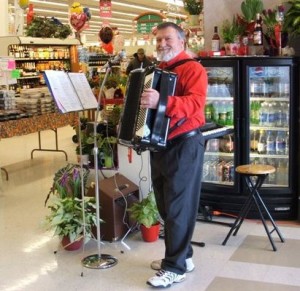![]() The word accordion comes from the German word “akkord,” which means “agreement, harmony.”
The word accordion comes from the German word “akkord,” which means “agreement, harmony.”
On April 18, 1939, Joe Biviano, Abe Goldman, and Gene von Halberg became the first people in history to play the accordion in Carnegie Hall. Their selection, but of course, was an eery selection–Bach’s “Tocattaa and Fugue in D Minor.”
There used to be a game show/talent contest on television in the Soviet Union that was called “Play Your Accordion!”
On April 20, 1931, Cornell Smelser, backed by the Ohman-Arden Orchestra, became the first accordionist in history to play Gershwin’s “Rhapsody in Blue” on the radio.
Professor Willard Palmer is credited with having the longest continuous master’s degree program in accordion ever (it was at the University of Houston ). Palmer also appeared on the television show, ” America ‘s Funniest Videos” playing the “Beer Barrel Polka” on the accordion. It fell apart in the middle of the song.
The first color documentary about accordion production was released in 1954.
Accordionist Myron Floren joined the Lawrence Welk Orchestra on March 7, 1950 in St. Louis after being asked by Welk to sit in during Welk’s first set on the songs “Roll Out the Barrel,” “Lady of Spain,” ” 12th Street Rag,” and Welk’s own “Baby Medley”; by intermission, Welk offered him a job. An accrdionist player since the 1930s, Floren first played on the radio in 1939 on KSOO in Sioux Falls . Floren had been an accordion teacher, a member of the country western band, the Buckeye Four in St.Louis, and an entertainer for the troops in World War II. To this day, even though Welk retired in 1981, Floren plays 150 dates a year; for the last 25 years in a row he has performed at Wurstfest in New Braunfels .
In 1990, there were an estimated 75,000 accordionists in the United States .
Pietro Deiro, known by all accordionists as “the Daddy of the Accordion,” was born in Salto , Italy in 1888. Eventually, he established a vaudeville career in San Francisco and got signed to RCA Victor Records. He died Nov. 3, 1954.
Former Boston Celtics player Tony Lavelli used to play his accordion at half time.
Tchaikovsky used the accordion in his Suite No. 2 in C major in 1883. Prokofiev used the accordion in his Cantata for the 20th Anniversary of the October Revolution, op. 74.
The cities of Detroit , Skokie , Illinois , and St. Paul , Minnesota have designated the accordion as their official instrument.
The Golden Encyclopedia of Music by Norman Lloyd describes the accordion as “an organlike piece of furniture (that was) dear to the Victorians.”
The accordion was used extensively in the score of the television series “Wagon Train.”
In China , the accordion is known as the “Sun-Fin-Chin”; in Russia , it is the “bayan”; in Norway the “trekspill”; and in Italy , the “fisarmonica.”
Carl Finch decided to trade in his Fender Rhodes for a beginner’s accordion. As Finch puts it, just the sight of the accordion was enough to win over the crowd and national press. Since then, Finch says that watching the transformation of peoples’ attitudes toward accordions has been one of his most rewarding experiences; the band has even seen accordion ensembles in Japan . He also says that one of his favorite aspects about the instrument is that it’s so physical and responsive to a player’s emotions. Finch, who led the accordion parade scene in David Byrne’s movie “True Stories,” adds that Byrne is a charter member of the Dallas chapter of the Texas Accordionists Association.

